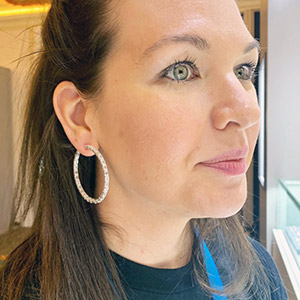
After 20 years of covering jewelry for British Vogue, Carol Woolton has focused her vast knowledge about the world of jewels on what she describes as “the seven adornments we’ve worn from antiquity” for the book If Jewels Could Talk: Seven Secret Histories.
In the book, which will be published on Sept. 26 by Simon & Schuster, Woolton identifies (for the first time) the seven types of jewelry that link people and cultures around the world: hoops, rings, beads, charms, brooches, cuffs, and head ornaments.
If Jewels Could Talk is also the name of a biweekly podcast hosted by Woolton, who was the first-ever jewelry editor at Tatler magazine. She spoke with JCK about the kind of surprising jewelry history she shares in the book.
What inspired you to write this book?
I wanted to write a book, rather than curate a book of glossy imagery of jewelry, because more than anything else we wear, jewelry speaks about us. Our style, the identity that’s important to us, bygone eras, important memories, our family and loved ones are all wrapped up in these small objects.
Jewelry isn’t purely a visual language—it talks. As well as talking, jewelry connects. It’s our longest-held cultural tradition, and links us all to whatever culture or civilization we’re born into. It’s also the great connector between the past and the future.
I’ve been telling stories for some time as I speak with guests on my podcast, and I wanted to commit [to print] some of the tales, anecdotes, interesting facts, and forgotten histories that we discuss on the podcast as well as current design and how the future of the jewelry landscape looks in the Metaverse and with AI fast approaching.
What would you like people to discover about jewelry?
I feel that jewelry lies at the intersection of everything—war, revolution, design, fashion, the slave trade, art, sculpture, personalities, geology, royalty, architecture, culture, religion, politics—so through telling these stories about jeweled objects, human history is revealed in the narrative.
[The book is] a way to get people to engage with the subject who aren’t convinced of its importance in our lives. Sure, jewelry adds glitter and shine to an outfit, but it has a depth like nothing else we wear—stretching back to the beginning when the first shell bead was drilled to wear.
What did you discover in the process of writing this book?
I’m endlessly surprised how fresh and modern ancient jewelry looks. Queen Puabi’s golden hoops circa 2600 B.C., you could wear today. I credit the hoop as our first fashion accessory—which we’ve been obsessively holding on to ever since.
What were other interesting revelations for you?
The fact that everything has a precedent, and when you know the history it makes sense of the present. Piercings have always had a subversive connotation. During the golden age of piracy in the 17th and 18th centuries, much of Europe had a number of laws in place that regulated people’s attire, prescribing what colors people could wear and controlling who could sport jewelry. Men weren’t allowed to wear jewels, and anyone who refused to obey these laws could face a heavy fine or even jail. Flamboyant pirate dress and gold jewels may well have been a direct response to these laws, making their earrings a symbol of rebellion and a subversive choice to flout rules.
And during the 13th century, the Catholic Church banned ear piercing, claiming that it was unduly altering one’s appearance as created by God. More rules to flout. I’m waiting to see if the modern piercing parties held now for mothers and daughters will mean the piercing loses its rebel rep.
Tell us about one way jewelry was used historically for nonverbal communication.
During the late 1870s a pretty invention became popular which consisted of two rings—one round for the little finger, which was connected by a gold chain to an octagonal ring bearing the name of the owner, through which the handkerchief was passed. In those days, the only acceptable way for a woman to communicate her feelings and intentions in public was through nonverbal communication, and the handkerchief ring proved to be a much more efficient messenger of coded signals.
For example, when the handkerchief was removed from its ring and folded, it meant, “I want to speak with you,” whilst “I love you” was conveyed by brushing it softly against her cheek. Winding the handkerchief around the forefinger broke the disappointing news to a suitor that a lady was engaged. In flirtations, these rings made for invaluable instruments for lovers. The demise of this ring is a loss for the romantic. Text messages don’t have the same intrigue, nor do they leave anything to interpretation.
What about jewelry for political rather than social communication?
People throughout history have often worn pins to demonstrate political allegiances as well as protesting—using visual decorative objects to recognize other like-minded people. In 1787, when women pinned certain jasperware medallion brooches in their hair, they were showing their support for the anti-slavery campaign. These oval white plaques depicted a black enslaved man in the act of praying—his hands clasped together, his arms chained to his legs, his right knee to the ground—with the molded letters above, “Am I not a man and your brother?” The image was taken from the seal of the London-based Society for Effecting the Abolition of the Slave Trade, and the medallion brooches became an emblem of the anti-slavery movement in Britain, France, and the United States.
And by 1903, women aligned to the cause of achieving the same voting rights as men [were] wearing brooches which were effectively a mission statement advertising membership in the Women’s Social and Political Union, founded by activist Emmeline Pankhurst. The brooches were fashioned in enamel, with emerald, amethyst, and pearl representing hope, dignity, and purity, voicing the courage of these women who were willing to use every weapon in their arsenal, from petitions and speeches to pins, parades, and attention-grabbing stunts.
We have plenty in the current epoch to protest for and against, and I wish people could show their diverse allegiances through the wearing of a decorative object, without fear of recrimination. During times of conflict and war, people traditionally turn to wearing patriotic style pins, but at this moment perhaps some young designers could revive the ’70s peace emblem in brooch form and a jewel could express the hopeful sentiment of our era.
Follow me on Instagram: @anniedavidsonwatson
- Subscribe to the JCK News Daily
- Subscribe to the JCK Special Report
- Follow JCK on Instagram: @jckmagazine
- Follow JCK on X: @jckmagazine
- Follow JCK on Facebook: @jckmagazine







